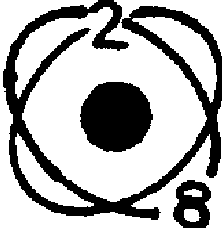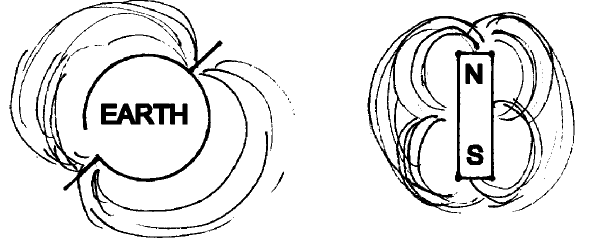BACKGROUND:
 The atom and how the
electrons spin around the nucleus is important to
understand magnetism.
The center is the nucleus where all the neutrons, protons and other
particles are located. The other "orbits" are the electrons.
There are set orbits for so many electrons. For instance the first orbit
would only have two electrons. The second orbit would have 8 electrons.
Draw the diagram on the right to help illustrate this point. Point out
that matter is made up of all the components of the atom. Protons are
positive, electrons are negative, and neutrons are neutral. The atom and how the
electrons spin around the nucleus is important to
understand magnetism.
The center is the nucleus where all the neutrons, protons and other
particles are located. The other "orbits" are the electrons.
There are set orbits for so many electrons. For instance the first orbit
would only have two electrons. The second orbit would have 8 electrons.
Draw the diagram on the right to help illustrate this point. Point out
that matter is made up of all the components of the atom. Protons are
positive, electrons are negative, and neutrons are neutral.
Electrons
spin around the protons, neutrons and other particles are also moving
within the nucleus. In most substances, half of the electrons spin in
one direction (clockwise) and the other half spin in the other direction
(counterclockwise). However in some substances like iron, nickel, and
cobalt, the electrons naturally spin more in one direction
than another.
In other substances, you can temporarily
change the direction by
physically making them align themselves in the same direction. The
spinning causes magnets to generate a force. The spin of the electrons becomes very important in understanding magnetism. If they are all
aligned in the same direction, the magnet will be stronger.
PROCEDURE:
- Students will learn that electricity is when
electrons move in one direction. To compare electricity and magnetism,
use the following example: Have several students spin in place, half
spin one direction, half spin in the other direction. This is how most
matter's electrons move. While students continue to spin, have them all
move in the same direction by taking 2 or 3 steps. This is electricity;
electrons move in the same direction. Have the students stand still and
spin in one direction, this is a simple example of magnetism. (Students
might get dizzy if you have them spin too much!)
- Magnetism has a force that attracts certain
substances. Many metals are influenced by magnets. Review with students
what is considered "magnetic" and "non-magnetic."
Have students use the magnets from the previous lab to make a list of
items in the class that are magnetic as opposed to those items that are
not affected. Note: A computer or television can be ruined by putting a
magnet near them. Caution students not to put a magnet on them because
they will be damaged.
- You may want to draw the diagram below that
illustrates that the Earth has a magnetic force similar to that of a bar
magnet. That is why we have a North and South Pole.

|